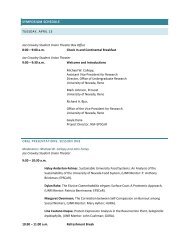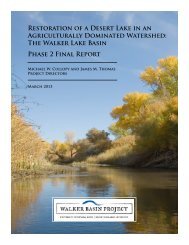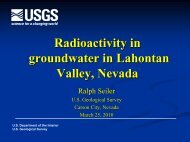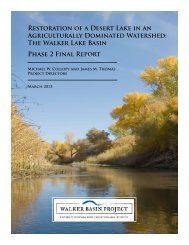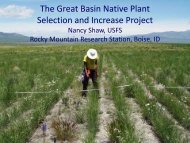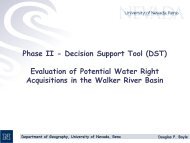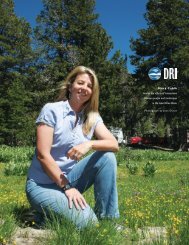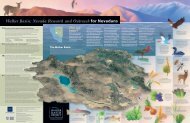Student Research Programs - Office of Undergraduate and ...
Student Research Programs - Office of Undergraduate and ...
Student Research Programs - Office of Undergraduate and ...
You also want an ePaper? Increase the reach of your titles
YUMPU automatically turns print PDFs into web optimized ePapers that Google loves.
delivering beads into an optical cavity for levitation. Beads <strong>of</strong> this size are subject to the van der Waals force <strong>and</strong><br />
will adhere strongly to any surface. One method for successfully launching microscopic glass beads is to place<br />
them on a surface to which a vibration is applied. If the vibration is sufficient, the beads will bounce <strong>of</strong>f <strong>of</strong> the<br />
surface <strong>and</strong> into the air. In order to control the frequency <strong>of</strong> the vibration, a piezoelectric material can be<br />
attached under the surface on which the beads rest. These materials contract <strong>and</strong> exp<strong>and</strong> proportional to an<br />
applied voltage allowing vibrational motion <strong>of</strong> the material in a controlled way. Applying a voltage such that the<br />
piezoelectric material vibrates on resonance will amplify the force felt by the beads. With a force larger than the<br />
van der Waals force, the beads will detach. Once free <strong>of</strong> the surface they can be optically trapped <strong>and</strong> levitated<br />
by a focused laser.<br />
AN ANALYSIS OF THE NEARSHORE WATER TEMPERATURES OF LAKE TAHOE<br />
Sarah Calhoun<br />
Program: NSF REU<br />
Mentor: Sudeep Ch<strong>and</strong>ra<br />
Department: Natural Resources <strong>and</strong> Environmental Science<br />
University <strong>of</strong> Nevada, Reno<br />
Lake Tahoe is a large freshwater lake that has been studied extensively over the<br />
last 50 years, primarily for the factors that are changing <strong>of</strong>fshore clarity.<br />
Decreasing <strong>of</strong>fshore clarity is attributed to rising temperatures <strong>and</strong> the current<br />
nonnative species that inhabit the lake, causing unfavorable changes in the<br />
ecosystem. Both <strong>of</strong> these factors can be associated with the development that<br />
continues to occur around the coastal areas <strong>of</strong> the lake <strong>and</strong> the interaction <strong>of</strong><br />
people with nearshore habitats. The nearshore environment is the area that most<br />
visitors to the lake spend their time. It is also the area <strong>of</strong> the lake where many invasive species are establishing,<br />
such as warmwater fishes. Recent studies suggest that the establishment <strong>of</strong> these fishes may be partly due to<br />
increases in nearshore temperature due to climate change. The probability <strong>of</strong> these nonnative species increasing<br />
in numbers <strong>and</strong> spreading to the <strong>of</strong>fshore areas increases if the temperatures continue to rise. In this study we<br />
examine the mean summer temperatures in the nearshore areas around the lake through the use <strong>of</strong> periodic<br />
temperature loggers. Taking a closer look at four particular sites existing in marinas <strong>and</strong> open water, this study<br />
points out the differences in temperatures around the lake <strong>and</strong> the effects <strong>of</strong> cultural eutrophication in Lake<br />
Tahoe. A literature search on invasive species <strong>and</strong> their temperature-preference relationships was also conducted<br />
to gain an underst<strong>and</strong>ing as to why such species occur around Lake Tahoe. This study will further the<br />
underst<strong>and</strong>ing <strong>of</strong> ecological effects caused by current <strong>and</strong> potential invasive species <strong>and</strong> the overall effects <strong>of</strong><br />
warmer nearshore temperatures on a large freshwater ecosystem.<br />
CHARACTERIZATION OF LANA’S ROLE IN THE RECRUITMENT OF TOPOISOMERASE II BETA<br />
Nathan Carter<br />
Program: NIH INBRE<br />
Mentor: Subhash Verma<br />
Department: Biology<br />
University <strong>of</strong> Nevada, Reno<br />
Kaposi’s Sarcoma-Associated Herpesvirus (KSHV) also called Human Herpesvirus<br />
8, is a member <strong>of</strong> the gammaherpesvirus family, <strong>and</strong> is associated with human<br />
cancers including Kaposi’s Sarcoma, Primary Effusion Lymphoma, <strong>and</strong><br />
Multicentric Castleman’s Disease. KSHV, like other herpesviruses, establishes life<br />
7



